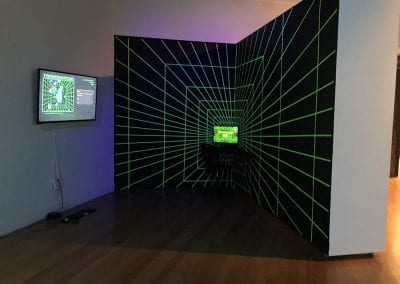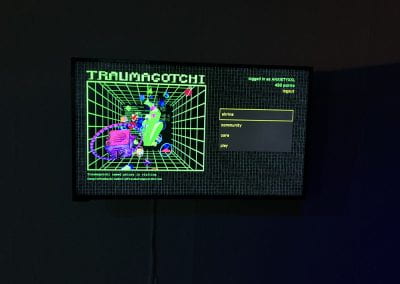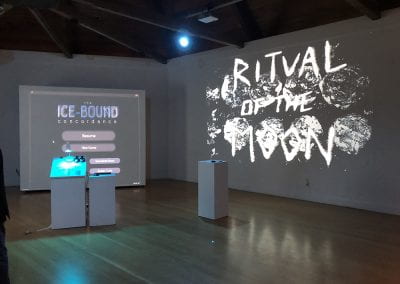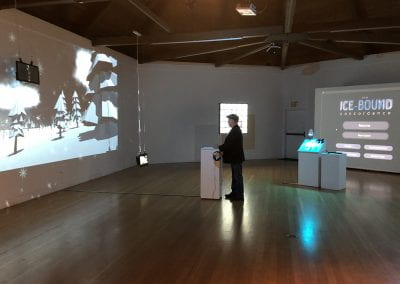
Queer Technology
Project description
Berkeley Art Center, Berkeley CA
July – September 2018
Artists:
Jacob Garbe & Aaron Reed
Ice-Bound 2016, Digital Game and Printed Book
Lark VCR
Traumagotchi 2018, Web-based Game
Kara Stone
Ritual of the Moon 2016, Digital Game
Colleen Jennings
Virtual Apparitions 2018, Video Projection, Insulation foam, foam board and wooden frame
Rudy Lemke
Cloud Forest / Annunciation 2018, six-channel video and game installation
Queer Technology
The discourse of contemporary technology tells us that these technologies are neutral and transparent designed to satisfy each individual’s desires. What if those desires are outside the norms encoded in software, hardware and delivery systems? How are these assumed cultural “norms” – heterocentric, masculinist, monogamous, rigidly gendered – written into this “transparency” that we take for granted? What are the internal workings and judgments encoded in the AI that now observes, tracks, mediates and filters our every move – our bodies and our psyches – and feeds back a computer vision of the perfect techno-capitalist self? Are software and circuits gendered male – the vast majority of engineers are men – are those codes non-binary, non-diverse – most tech workers are white, heterosexual indentified? The naming of variables, routines and functions are the imagination of the Engineer. How has this naming excluded Queer possibilities? What are the political, economic and social ramifications of a cultural bias inscribed in the technologies we live and interact with everyday?
This exhibition of Queer Technology responds to these questions and others by inviting Bay Area LGBTQ artists to critique the norms and values assumed by the techno-sphere. These artists and their work interrogate and confront their exclusion through a Queer ontology. Queerness as such exists performing its Otherness as a way of being and thereby deconstructs a confined and restrictive techno-cultural identity and experience. Underlying representations in interactive technologies are codes, mechanics and structures that function to instantiate a techno-ontology. As an example game characters act, appear and behave – often violent and masculine – according to AI self-mechanics. Queer Technology hacks and recodes this AI-being undoing techno-existence by celebrating fluidity, diversity, a multiplicity of genders, intersectional experiences, powerful political affect, irony and humor. Queer Technology is a “read” and throwing some “shade” – in the language of trans/drag – on the conditions of “transparent” techno-culture creating possible Techno-Trans-Parency.
These Bay Area Queer Technologists create games, augmented virtual reality artworks, sound and music, sculpture, Internet-based, video and performance artworks that expose us to other possible techno-worlds. Their work is inviting and critical, intersectional and intersexual, observational and engaged, political and entertaining, immersive and inclusive, randy and serious. These artists express Queerness through their artwork as an essential diverse counter-narrative to the givens of our technology grounded and inscribed experiences and lives.
Colleen Jennings Virtual Apparitions 2018
Video Projection Insulation foam, foam board and wooden frame





